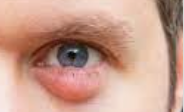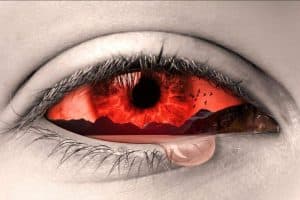If you suffer with sore eyes, published studies suggest that up to 78% of adults have a form of Ocular Surface Disease.
What is ocular surface disease and can it be treated?
Here are 5 of our most frequently asked questions – and answers – about the treatments for ocular surface disease.
Q1: What is ocular surface disease (OSD)?
Ocular surface disease is a general term covering a number of different, but similar, eye conditions that can affect the tear film over the eye, drying it out.
Ocular surface diseases often remain undiagnosed and not fully treated.
Examples of conditions that fall under the umbrella of ocular surface disease include:
- Dry eye syndrome
- Blepharitis – inflammation of the eyelids
- Side effects from medications
- Meibomian gland dysfunction – problems with the oil secreted by the glands in the eyelids
- Irritation caused by allergies – such as pollen and pet dander
- Ocular reaction to environmental irritants – such as smoke or pollution
- Inflammation, burning and itching – also known as rosacea of the eye
Q2: How is OSD diagnosed?
Eye care professionals who specialize in the diagnosis and treatment have a range of specific equipment to run the tests necessary to diagnose the causes of the problem and discuss a range of successful treatment options.
Among the tests used to detect OSD are:
1 Schrimer’s test
This is probably the most common test, and is used to show the eye doctor the volume of water in your tears.
Your eye doctor will place a small strip of medical paper inside your lower eyelid and ask you to close your eyes on the strip.
Once you open your eyes the doctor will evaluate how far your tears travelled on the paper while your eyes were closed. The farther the tears travel, the more water is present in your tears.
2. Meibomian gland evaluation
Eye doctors have a range of digital devices which scan and detect the activity of the meibomian glands, located in the eyelids.
New technologies allow your eye doctor to accurately determine the functioning of the meibomian glands, which produce the vital oily layer in the tears.
During this test your eye doctor will gently press on the tiny oil glands, called meibomian glands, that line the edges of your eye lids, and which produce oil to help keep tears from evaporating too quickly.
Eye doctors can also manually examine these glands by gently pressing on the eyelid margin and evaluating the quality and quantity of the oil secreted. If there seems to be a problem, this is likely at least one factor causing your OSD.
3. Tear and corneal evaluation
Your eye doctor will carefully look at your cornea and tears under magnification to evaluate the health of the cornea and examine the volume and quality of your tears.
In this test, your eye doctor uses orange dye and a blue light to examine the tears on your eye. Your eye doctor can then see the tears more clearly and will be able to evaluate their rate of evaporation.
The doctor will also diagnose any corneal damage that may have resulted from your OSD.
After these tests are run, your eye doctor will have a better sense of underlying issues, and will be able to more accurately decide on a course of treatment.
SEE RELATED: 8 Top Natural Ways to Stop Dry Eyes
Don’t let dry eyes impact your life, see an eye doctor near you for a comprehensive examination and treatment.
Q3: Can eye doctors treat ocular surface disease?
Yes.
Eye doctors have a range of successful treatment options for OSD.
Determining the cause of OSD is essential, this will allow the eye doctor to prescribe the most effective treatment option.
Effective treatment for ocular surface disease will depend on the specific condition and cause of the symptoms.
Usually treatment will include any combination of the following:
- Prescribed artificial tears
- Gel-based eye drops
- Cyclosporine
- Antibiotic drops and ointments
- Non-steroid anti-inflammatory medications
- Eyelid scrubs
- Warm compresses and eye massages
In severe cases, your eye doctor may prescribe antibiotics to be taken orally, or topical steroid treatments.
In cases of blepharitis, the most effective procedures are provided as in-office treatments using a range of non-invasive devices. These devices warm up the glands to clear out the oil at the edge of the eyelids and decrease symptoms of OSD.
Q4: Can eye surgeries like LASIK cause ocular surface disease?
LASIK and similar surgeries can actually worsen OSD and dry eye symptoms.
LASIK requires the opening of a flap in the outer part of the cornea. Although eye doctors are well-practiced and use the latest technologies when performing these surgeries, damage can still occur to the nerves in this area of the eye.
Any disruption of the corneal nerves can disrupt the normal nerve impulses that stimulate tear production, leading to exacerbation of symptoms associated with OSD.
In most cases, post-surgery symptoms are mild to moderate, and don’t last longer than a week. However, rare cases of post-surgery OSD can last for a year or longer.
Patients already diagnosed with dry eye syndrome may not be good candidates for LASIK.
Q5: Can children have ocular surface disease?
Yes. OSD can have a debilitating effect on a child’s life if it goes untreated, so early diagnosis and treatment is essential.
Among the reasons a child might experience ocular surface disease are:
1. Allergies
As with all of us, allergy season can cause children’s eyes to become red, itchy and dry. Anti-allergy treatments, eye drops and artificial tears should be able to help treat symptoms associated with allergic reactions.
2. Poor diet
Children can sometimes be picky eaters, making it hard for parents to get them to eat much of anything with nutritional value.. As with the rest of the body, this poor nutritional situation can create problems for the eyes, including OSD.
3. Genetics
Children can have OSD as a result of hereditary diseases and dysfunctions.
Riley-Day syndrome is a congenital disorder of the autonomic nervous system that can cause a child to have a chronic deficiency in the production of their tears. In extreme cases, tears are not produced at all.
In these cases, the insufficient or non-existent tear production can cause severe OSD that can develop into a sight-threatening condition if left untreated.
Depending on the cause, treatment for ocular surface disease in children is as successfully managed as that of adults.
LEARN MORE: Guide to Dry Eye
If dry eyes are affecting your life, see an eye doctor near you to discuss the range of successful treatment options
Ocular surface disease is a serious eye condition that can lead to permanent corneal damage and affects up to 4 in 5 of all adults.
Your eye doctor can determine the cause and discuss a range of effective solutions.









